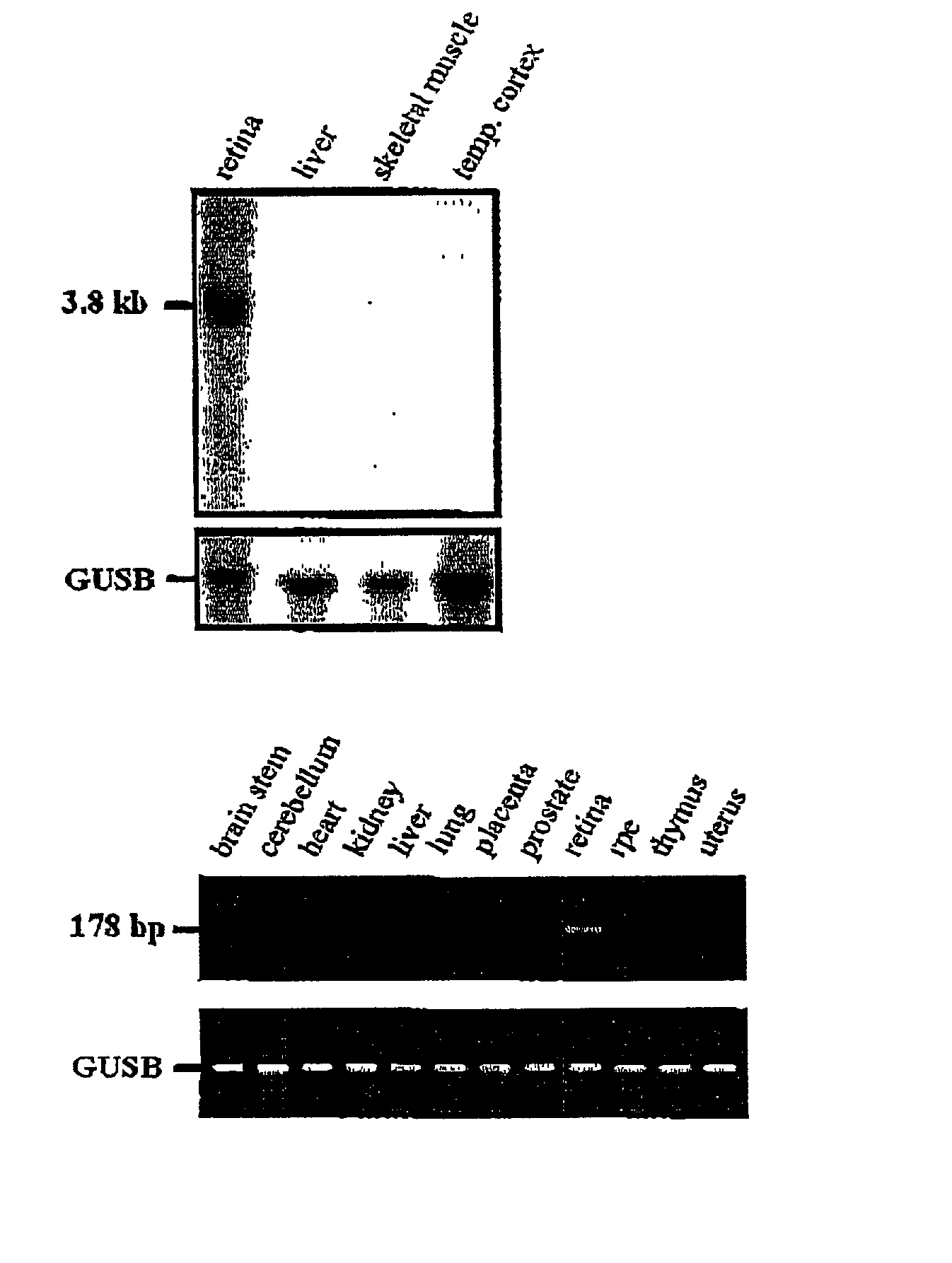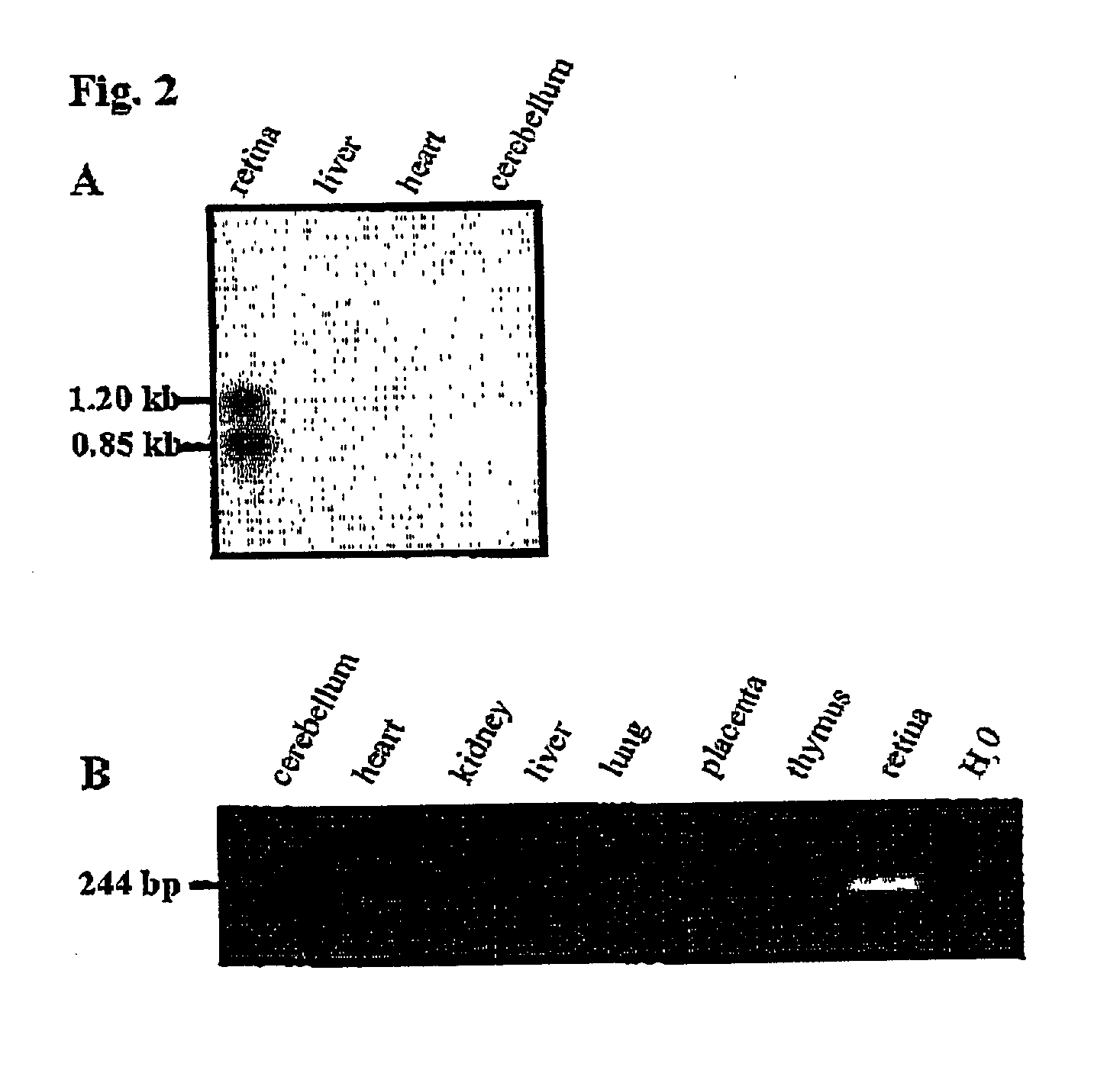Novel retina-specific human proteins C7orf9, C12orf7, MPP4 and F379
a human protein and retina-specific technology, applied in the field of retina-specific human proteins c7orf9, c12orf7, mpp4 and f379, can solve the problems of progressive destruction, design and interpretation of data, and difficulty in applying conventional approaches for the identification of genes predisposing to diseas
- Summary
- Abstract
- Description
- Claims
- Application Information
AI Technical Summary
Problems solved by technology
Method used
Image
Examples
example 1
MPP4
(A) Isolation of MPP4 CDNA
[0094] The publically accessible UniGene dataset, release no. 113 (June, 2000), at the National Center for Biotechnology Information (NCBI) at the National Institutes of Health (NIH), Bethesda, Md. (http: / / www.ncbi.nlm.nih.gov / UniGene / ) was searched for human EST clusters consisting of ESTs exclusively derived from retina cDNA libraries or for EST clusters with an enrichment of retina ESTs, defined by a portion of retina ESTs that is greater than 30% of the total. One of the 1241 entries meeting these criteria, Hs.60673, contained EST sequences from the 5'- and 3'-ends of two nearly identical cDNA clones isolated from the Soares retina N2b4HR cDNA library (ze39a04, ze32b03) (http: / / www.ncbi.nlm.nih.gov / Genbank / GenbankOverview.html.) Reverse transcription (RT)-PCR using oligonucleotides A128F (5'-CTC ACA TCC TTC TCA GCC-3') and A128R (5'-GTG GAA TGT CAG GGA AAT C-3'), priming to sequences in the 5' reads of the cDNA clones, amplified a 193 bp transcript ...
example 2
C7orf9
(A) Isolation of C7orf9 cDNA
[0105] The publically accessible UniGene dataset, release no. 113, was searched for human EST clusters consisting of ESTs exclusively derived from retina cDNA libraries or for EST clusters with an enrichment of retina ESTs, defined by a portion of retina ESTs that is greater than 30% of the total. One of the 1241 entries meeting these criteria, Hs.60473, contained approximately 350 bp of high quality EST sequences from the 3'-ends of two cDNA clones (ze34f06, ze37g05) isolated from the Soares retina N2b4HR cDNA library. The approximately 280 bp high quality EST sequences of the 5'-end of the cDNA clones available at the dbEST database (http: / / www2.ncbi.nlm.nih.gov / dbST / dbest_query.html) do not overlap with the corresponding 3'end ESTs.
[0106] To isolate further cDNA clones representing this gene, a retina lambda-Trip1Ex2 cDNA library was screened with a radio-labeled 199 bp DNA fragment obtained by PCR amplification of genomic DNA with primers A129F ...
example 3
F379
(A) Isolation of F379 EDNA
[0114] The publically accessible UniGene dataset, release no. 113 was searched for human EST clusters consisting of ESTs exclusively derived from retina cDNA libraries or for EST clusters with an enrichment of retina ESTs, defined by a portion of retina ESTs that is greater than 30% of the total. One of the 1241 entries meeting these criteria, Hs.35493, contained 22 EST sequences from the 5'-and / or 3'-ends of 15 cDNA clones isolated from the Soares retina N2b4HR cDNA library (ys82h08.rl, ys82h08.sl, ys66e12.rl, ys66e12.sl, ys84g04.rl, ze4g 02.rl, ys84c02.rl, ze42b07.sl, ze42b07.rl), the Nathans human retina cDNA randomly primed sublibrary (39a12) the Soares pineal gland N3HPG cDNA library (zf67e04.rl, zf67e04.sl, yt90d11rl, yt90d11.sl, yt84g01.rl, yt84g01.sl, yt83g01.sl, zf82e10.sl, zf82e10.rl, zf86d88.sl), the Soares fetal heart NbHH19W cDNA library (zd74d06.rl, zd74d06.sl) and the Soares testis NHT (ot33d09.sl) (http: / / www.ncbi.nlm.nih.gov / Genbank / Gen...
PUM
| Property | Measurement | Unit |
|---|---|---|
| molecular mass | aaaaa | aaaaa |
| molecular mass | aaaaa | aaaaa |
| nucleic acid | aaaaa | aaaaa |
Abstract
Description
Claims
Application Information
 Login to View More
Login to View More - R&D
- Intellectual Property
- Life Sciences
- Materials
- Tech Scout
- Unparalleled Data Quality
- Higher Quality Content
- 60% Fewer Hallucinations
Browse by: Latest US Patents, China's latest patents, Technical Efficacy Thesaurus, Application Domain, Technology Topic, Popular Technical Reports.
© 2025 PatSnap. All rights reserved.Legal|Privacy policy|Modern Slavery Act Transparency Statement|Sitemap|About US| Contact US: help@patsnap.com



